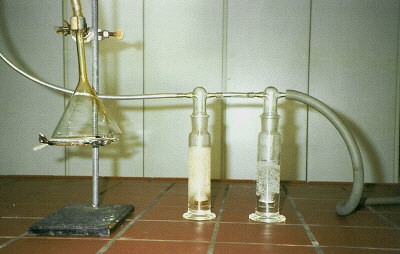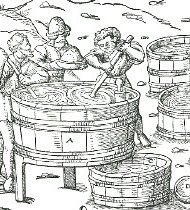Making a Proper Slow Match
A historical review
No
doubt, before the invention of match-sticks in 1829 by J. Walker, a
slowly smoldering cord, called match, was the only way to carry a
readily available fire all day long with you. It obviously was so
common, the match sticks of today adopted the name of the former cord.
By
the way, the English word "match" originates from the Greek word
"mixa". From there, it first migrated to Rome were it was changed to
"mica". Then the French inherited the Latin word and called it "mèche".
And, finally, the English changed the French word to "match", after may
be 2000 years of migration through the old world . So, with this
linguistic review, the utmost importance of the smoldering cord over
centuries is made clear.
The oldest recipe for
making a match I found in Grimmelshausen's "Simplicissimus" (published
1668). No doubt, Grimmelshausen was an expert. He served the catholic
side as a captain in the 30-years war (1618-1648), which was the last
war predominantly fought by match-lock musketeers. There, the
musketeers used a tightly twisted hemp or flax cord, which they boiled
in a pot, filled with ash and water.(They didn't filtrate the ash
residue before boiling).Then the match was thoroughly rinsed with
plenty of water and dried. After this it was ready for use. As an
allowance, Grimmelshausen reveals to us, what else a match was used for
in the 30-years war:
- Hanging spies and deserters,
- Timing the relays of the watch. One relay went one shoe (foot) of the burning match. (That was about one and a half hours)
- Torturing
enemies: He tells us a story about a bunch of soldiers who used a
knotted match for sawing off a poor enemy's leg who refused to give
away information voluntarily.
Grimmelshausen gives us also a definition of an ideal match. He stated:
An ideal match
- is never consumed,
- burns hot and ash-free, and
- is waterproof.
Goals certainly never achieved.
A
match was always made from flax or hemp, though nowadays, there are
some modern musketeers who make matches from cotton. But cotton never
yields a good match, - it burns with too little ember.
| Fig. 1: This beautiful match lock gun (ca. 1600) was copied by the very skilled US-gunsmith, Jurgen Kreckel, Saylorsburgh PA, in 1993, from an original, displayed at the Poldi-Pezzoli museum in Milano (Italy) |
|||
| Fig. 2: Note the sharply pointed ember of the match, aiming towards the center of the priming pan. |
|||
A recipe for making a competitive slow match
1. Bucking
Raw
textile fibers contain a lot of lignin. Plants need this brown colored
lignin as a glue to bond its cellulose fibers. But you, as a musketeer,
have to get rid of this lignin, since it produces most of a cord's ash.
If
the match, used in a match lock musket, produces a lot of ash, this ash
may drop in the open priming pan while aiming and then ignite the gun
involuntarily. So watch out, always blow off the ash from the match
before opening the pan of your musket! Even a bucked match yields some
ash.
For bucking a rope, you boil
it in a potash solution which dissolves the lignin. Common ash, e.g.
from your fire place, contains about 10% potash (potassium carbonate, K2CO3) by weight. It is very alkaline. But you may buy the potash in a drugstore, too.
By the way, the meaning of "bucking" is to boil a textile in a bucket (German: beuchen)
2. Leading
The
leading of the match gets us closer to Grimmelshausen's ideal match,
though this process is not mandatory. A leaded match burns
significantly slower and hotter than an unleaded match. Here, lead
acetate serves as a catalyst to control the burning of a match,
comparable to the lead-tetra-ethylene used as an additive to gasoline.
At least untill the advent of the catalytic converter.
I
don't know, if the leading of a match was known to Grimmelshausen. He
didn't mention it. Certainly it was used in the 19th century, where
slow matches still were used by the artillery.
Instruction for making a homemade match
I
usually buy 10 meters of flax cord with a diameter of 6 millimeters,
jacketed with a braided mantel. Twisted cords are not recommended:
Their burning end untwists and forms a brush. What we need is a sharply
pointed ember.
Line a stainless steel pot with
a hand-towel and fill it with about two liters of ash from your
fireplace. (Never use an aluminum pot, since aluminum is soluble in
alkaline solutions !!!) Add 1.2 liters of hot water. Let it stand for
some minutes and then lift the towel to filter off the brine and wring
the residual solution from the ash cake inside the towel. That makes
about a 5% potash solution.
| Fig. 3: Stainless steel pot, lined with a towel and filled with ash. Standing on a gas burner on our kitchen hearth. |
|||
Coil
the cord loosely, fitting the size of the pot. Watch that the cord is
covered entirely by the brine. Then heat the pot until the brine just
starts to boil. Cover the pot to prevent evaporation and keep it just
below the boiling point for about an hour. (This process is called
"bucking" by the textile workers). Notice the peculiar smell which is
characteristic of any textile factory!
| Fig. 4: The coiled cord, ready to be lowered into the potash solution. |
|||
After
an hour has passed, discard the now coffee-brown brine and rinse the
bucked cord with plenty of water till the rinse water remains clear.
Add a cup of vinegar to the final rinsing for neutralizing the last
trace of potash (Important).
Then spin the cord coil in your washing machine at maximum speed and let it dry.
Prepare
about 100 milliliters of 5% lead acetate solution useing distilled
water (or rain water) and add two spoons of vinegar (the kind you use
to make salad dressing is OK). If a yellowish precipitation appears,
add some more vinegar. (This precipitation would be lead carbonate).
Put the dried match in a plastic bag and add enough lead acetate
solution to make the entire the cord just damp. Close the bag and tread
on it to knead it through. Season it for some hours, open the coil and
then pull the wet cord trough your rubber-gloved hand to wipe off any
surplus lead solution evenly.
Spread the impregnated,
damp match loosely and flat on the floor. This will guarantee it will
dry evenly. Otherwise lead acetate would concentrate at the last wet
remaining areas of the drying match.
Usually,
this match will burn at 20 centimeters per hour. Once pinched between
the lips of the serpent of your musket, you won't have to hurry up
firing. And note, never use saltpeter to "improve" the match. Such a
match would burn far to quick and sparkling and hence is prone to
ignite the priming charge unexpectedly.
Warning:
Lead acetate, also called "lead sugar", is very poisonous when
swallowed, whereas skin contact is harmless. Keep it out of reach of
children. Lead acetate tastes sweet. Chewing the leaded match would be
fatal.
My advice: If you live with small children, omit the leading of your match. Inform older children properly.
Is the inhalation of the smoke of a leaded match poisonous?
The
temperature of the ember of a smoldering match was measured at 750 °C.
At this temperature the catalyst lead acetate forms yellow lead oxyde
(PbO). How much of this compound evaporates at the given temperature?
To investigate this, I set up an apparatus according to the next picture.
 |
|||
| Fig. 5: Here we see the smoke of a 10 cm match cord beneath a funnel hood sucked through two washing bottles by a vacuum pump. |
|||
A
piece of bucked and leaded, burning match was placed on a wire gauze.
The smoke then was collected by a funnel and sucked through two
successive washing bottles, each filled with 10% nitric acid. After 10
cm of the match were consumed, the soot inside the funnel and the tube
was washed with nitric acid and united with the acid of the washing
bottels and then the amount of absorbed lead was determined.
It was found: The smoke of one meter of match contains exactly 1.0 milligram of lead (1.0 mg Pb/m).
This
is a surprising low concentration. If you, dear reader, would inhale
the smoke of one meter of match you'd rather die of smoke poisoning
than of lead poisoning. And by the way, watching motorized traffic
passing by on a busy street during rush hours would probably cause more
lead uptake than shooting a match lock musket at the shooting range all
day long.
